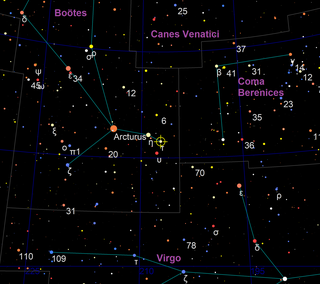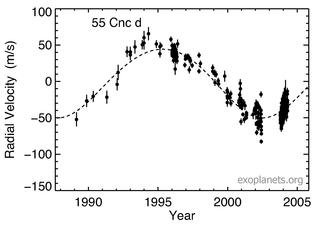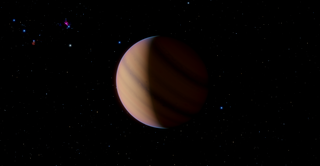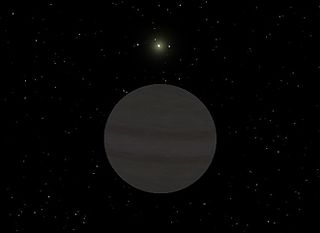
The International Astronomical Union is a nongovernmental organisation with the objective of advancing astronomy in all aspects, including promoting astronomical research, outreach, education, and development through global cooperation. It was founded in 1919 and is based in Paris, France.
PSR B1257+12, previously designated PSR 1257+12, alternatively designated PSR J1300+1240, is a millisecond pulsar located 2,300 light-years from the Sun in the constellation of Virgo, rotating at about 161 times per second. It is also named Lich, after a powerful, fictional undead creature of the same name.

Tau Boötis, Latinised from τ Boötis, is an F-type main-sequence star approximately 51 light-years away in the constellation of Boötes. It is a binary star system, with the secondary star being a red dwarf. As of 1999, an extrasolar planet has been confirmed to be orbiting the primary star. In December 2020, astronomers may have detected, for the first time, radio emissions from a planet beyond the Solar System. According to the researchers: "The signal is from the Tau Boötis system, which contains a binary star and an exoplanet. We make the case for an emission by the planet itself."
HD 149026, also named Ogma, is a yellow subgiant star approximately 250 light-years from the Sun in the constellation of Hercules. An extrasolar planet is believed to orbit the star.
14 Andromedae, abbreviated 14 And, also named Veritate, is a single, orange-hued giant star situated approximately 247 light-years away in the northern constellation of Andromeda. It is dimly visible to the naked eye with an apparent visual magnitude of 5.22. The star is moving closer to the Earth with a heliocentric radial velocity of −60 km/s. In 2008 an extrasolar planet was discovered to be orbiting the star.

55 Cancri c, formally named Brahe, is an extrasolar planet in an eccentric orbit around the Sun-like star 55 Cancri A, making one revolution every 44.34 days. It is the third known planet in order of distance from its star. 55 Cancri c was discovered on June 13, 2002, and has a mass roughly half of Saturn.

55 Cancri d, formally named Lipperhey, is an extrasolar planet in a long-period orbit around the Sun-like star 55 Cancri A. Located at a similar distance from its star as Jupiter is from the Sun, it is the fifth and outermost known planet in its planetary system. 55 Cancri d was discovered on June 13, 2002.

Upsilon Andromedae c, formally named Samh, is an extrasolar planet orbiting the Sun-like star Upsilon Andromedae A every 241.3 days at an average distance of 0.83 AU. Its discovery in April 1999 by Geoffrey Marcy and R. Paul Butler made this the first multiple-planet system to be discovered around a main-sequence star, and the first multiple-planet system known in a multiple star system. Upsilon Andromedae c is the second known planet in order of distance from its star.

Pollux b, also designated β Geminorum b and HD 62509 b, formally named Thestias, is an extrasolar planet approximately 34 light-years away in the constellation of Gemini. This planet was discovered orbiting the star Pollux in 2006 by astronomer Artie P. Hatzes, confirming his hypothesis originally published in 1993. The planet has at least twice the mass of Jupiter. It moves around Pollux in 1.61 years at a distance of 1.64 AU in a nearly circular orbit.

Mu Arae e, also known as HD 160691 e, later named Sancho, is one of the four extrasolar planets orbiting the star Mu Arae of the constellation Ara.
Mu Arae d, also known as HD 160691 d, formally named Rocinante, is an extrasolar planet orbiting the star Mu Arae of the constellation Ara.

55 Cancri f, also designated Rho1 Cancri f and formally named Harriot, is an exoplanet approximately 41 light-years away from Earth in the constellation of Cancer. 55 Cancri f is the fourth known planet from the star 55 Cancri and the first planet to have been given the designation of "f".
HD 104985, formally named Tonatiuh, is a solitary star with a exoplanetary companion in the northern constellation of Camelopardalis. The companion is designated HD 104985 b and named Meztli. This star has an apparent visual magnitude of 5.78 and thus is dimly visible to the naked eye under favorable seeing conditions. It is located at a distance of approximately 329 light years from the Sun based on parallax, but is drifting closer with a radial velocity of −20 km/s.

18 Delphini b, formally named Arion, is an extrasolar planet approximately 249 light-years away in the constellation of Delphinus.

14 Andromedae b, formally named Spe, is an exoplanet approximately 249 light years away in the constellation of Andromeda.

42 Draconis, formally named Fafnir, is a 5th magnitude K-type giant star located approximately 315 light years away in the constellation of Draco. As of 2009, an extrasolar planet is thought to be orbiting the star.
42 Draconis b, formally named Orbitar, is a candidate extrasolar planet located approximately 315 light years from Earth in the constellation of Draco. It orbits the 5th magnitude K-type giant star 42 Draconis with a period of 479 days and 38% orbital eccentricity. The planet was discovered using the radial velocity method on March 20, 2009.
HD 164604 is a single star in the southern constellation of Sagittarius constellation. It has the proper name Pincoya, as selected in the NameExoWorlds campaign by Chile, during the 100th anniversary of the IAU. Pincoya is a female water spirit from southern Chilean mythology who is said to bring drowned sailors to the Caleuche so that they can live in the afterlife. A 2015 survey ruled out the existence of any additional stellar companions at projected distances from 13 to 340 astronomical units. It is known to host a single super-Jupiter exoplanet.













